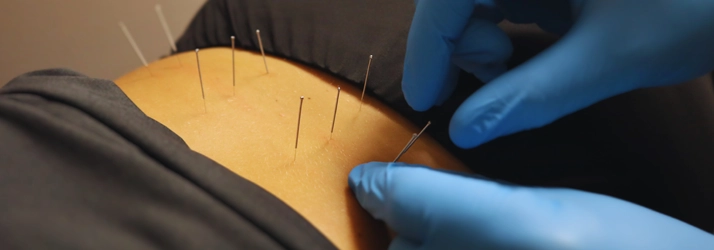How Dry Needling Can Help A Climbing Injury

Our doctor sustained a climbing injury after pushing himself hard for several days. While he was climbing, he felt a pop in a tendon in his hand which has been very painful. Laser therapy has helped him with this injury but after deciding to lift weights without allowing his injury time to heal, he injured it again. Dry needling is very effective on this sort of injury and in this article, you'll see a very nervous Doctor get dry needling for his climbing injury.
If needles make you nervous, you're in good company. This doctor is just as scared and nervous as you are but he makes it through dry needling and gets immediate relief from the pain he was feeling. Most of our patients handle dry needling much better than this doctor does, so if you want to see proof that even someone who is terrified of needles can make it through dry needling to get great results, read this article.
If you're a climber, chances are you have either had a finger injury, or you know someone who has. The most common finger injuries climbers experience are pulley injuries, with A2 pulley injuries being the most common.
Pulleys in our fingers function similarly to eyelets on a fishing rod. These pulleys work to keep the tendons that flex our fingers close to the bone which prevents the tendon from springing out like a bowstring. Pulleys are made of very strong connective tissue but climbers can put too much force on them which can result in a tear.
Pulley injuries are almost entirely exclusive to climbers and 40% of climbers report experiencing one. The most commonly injured finger is the ring finger, followed by the middle finger. Pulley injuries are graded on a scale from Grade I to Grade IV with the worst being Grade IV. These injuries can range from acute to chronic.
Pulley injuries tend to have a loud pop that's associated with them but you can still have a pulley injury without hearing a pop. A climber will feel a tweak and often hear a loud pop followed by pain, swelling and in some cases, limited mobility. This pain worsens when pressure is applied so doing something as simple as shifting gears in your car can be painful.
Climbers are most likely to experience pulley injuries because they crimp their hands when they climb. Crimping is a grip technique where a climber grabs the small edges with their fingertips flat on the surface while the fingers arch above their tips. The crimping position creates an angle that puts significant stress on the part of the A2 pulley closest to the proximal interphalangeal joint, which is why it is usually the first to go. When you exceed the force the A2 pulley can handle, the flexor tendon can tear partially or completely through the pulley. Extreme force can cause pulleys A3, A4, and A5 to rupture as well.
When a climber comes into our office with a climbing injury like a pulley injury, we start by observing the area and look for swelling. We then test to see which areas, if any, are very sensitive to pressure or touch. We examine the range of motion and in many cases we find a limited range of motion after a climbing injury. Every injury is different so we go through a series of tests to see exactly what your injury requires and then we create a custom treatment plan for you to get you feeling better faster.
How Dry Needling Can Help A Climbing Injury
Dry needling is a very common treatment we use for climbing injuries, particularly pulley injuries. All tissues (including muscles) respond to two different types of stimuli: chemical (ex: drugs or breaking the tissue) and mechanical (ex: massage or exercise). Dry needling uses very thin dry needles that puncture the skin and slide through the tissue. The needles provide a constant mechanical stimulus to the trigger points while they're in place, which is usually about 8-10 minutes.
The mechanical stimulus provided is similar to what your muscles would get from a massage but because the needle doesn't need to release pressure like a hand does when massaging a muscle, the pressure remains constant and is able to provide relief in a very short period of time.
In addition to the mechanical stimulus that dry needling provides, it is also an effective way to improve blood flow and oxygenation to damaged tissue. Dry needling provides a natural way to relieve pain using anti-inflammatory mediators that exist in the body to decrease the sensation of pain.
While the name may sound intimidating or painful, dry needling causes minimal discomfort if any. Our patients compare dry needling's effectiveness to that of multiple deep tissue massages, but in a fraction of the time. During dry needling, a patient may feel a twitch in the muscle as it releases tension.
We regularly use dry needling to treat a wide range of issues including sports injuries, disc injuries, TMJ, tendinitis, migraine and tension headaches, arthritis pain, fibromyalgia pain, plantar fasciitis, and joint pain. It's a drug-free treatment that gets fast results.
Do you have a sports or climbing injury? Click here or call our office today at (410) 296-7700 to schedule your appointment so we can create the right treatment plan for you and help you feel better faster.
IF YOU'D LIKE TO LEARN MORE ABOUT OUR NEWSLETTER, SUBSCRIBE BELOW
FOR MORE INFORMATION, FILL OUT THE FORM BELOW
OFFICE HOURS
Monday
7:30am - 12:00pm
2:00pm - 6:00pm
Tuesday
7:30am - 12:00pm
2:00pm - 6:00pm
Wednesday
7:30am - 12:00pm
2:00pm - 6:00pm
Thursday
7:30am - 12:00pm
2:00pm - 6:00pm
Friday
7:30am - 12:00pm
Saturday & Sunday
Closed
Kalkstein Chiropractic
200 E Joppa Rd #300
Towson, MD 21286